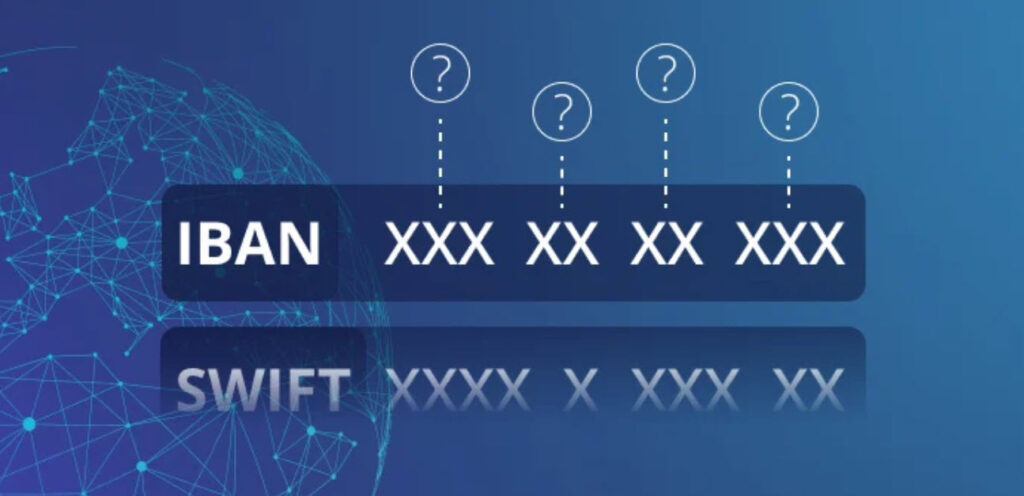
International money transfers have become as easy as possible. It has opened up global trade and expanded economic opportunities for individuals and businesses.
Whenever you want to make a foreign transfer, you’ll likely encounter a SWIFT code and IBAN. Financial institutions request these codes to process foreign transfers, and you should understand their characteristics and differences. This article will tell you what you need to know about them.
What Is A SWIFT Code?
SWIFT stands for Society for Worldwide Interbank Financial Telecommunications, a global communications network banks use to send and receive instructions. Every banking institution connected to this network is assigned a unique Bank Identifier Code, or SWIFT code.
What Does It Look Like?
It comprises 8 to 11 characters in this format; AAAABBCCDDD
- The first four characters (AAAA) identify the name of the banking institution. It’s usually a shortened version of the institution’s formal name.
- The next two characters (BB) indicate the country the banking firm is in.
- The next two characters (CC) indicate the banking institution’s head office.
- The last three characters (DDD) indicate the specific banking branch.
Here’s an example of a BIC/SWIFT code; WFBIUS6WFFX.
- WFBI stands for Wells Fargo Bank International.
- US stands for the United States of America, where Wells Fargo is based.
- 6W identifies Wells Fargo’s main office in San Francisco.
- FFX identifies a specific branch designated for foreign exchange settlements.
What Is An IBAN?
It is an abbreviation for International Bank Account Number. It is a generally accepted global system for identifying bank accounts to facilitate transfers. 77 countries adhere to this system.
What Does It Look Like?
It comprises a two-letter country code, two check digits, and up to thirty-five additional alphanumeric characters. The alphanumeric characters constitute the basic bank account number (BBAN).
Here’s an example of an IBAN; FR7630006000011234567890189.
- FR is the country code for France.
- 76 is the check digit.
- The rest of the digits are the basic bank account number.
All the 77 countries that accept the IBAN standard have a unique combination.
What’s the Difference Between IBAN and SWIFT Code?
The core difference is that a SWIFT code identifies a specific bank, while an IBAN identifies a specific bank account. The former tells you where to pay money, and the latter tells you who to pay the money to.
Where Can You Find the Codes?
- Bank statements. A formal banking statement usually contains your BIC or IBAN written at the top or bottom. You can contact your institution at any time to request this statement.
- Customer service. You can call your banking provider’s customer service line and request your BIC or IBAN.
- Ask the recipient. You can always ask the recipient of your intended transfer for the details.
- Online websites. Many websites aggregate BIC codes for different banks and display them to users. You can consult such a website.
- Official site. You can check your banking institution’s official website for a list of its BICs.
What Countries Use SWIFT and IBAN?
SWIFT is accepted by virtually all countries connected to the modern banking system. If your bank supports foreign transactions, it’s likely connected to the network.
IBAN is not as widely used as its counterpart. It’s accepted by only 77 countries, less than half of the formally recognized countries worldwide. The United States, the world’s biggest economy, doesn’t use IBAN. Other notable non-users include Canada, China, Australia, and New Zealand. However, all countries under the European Union (EU) use it.
You may also like:- WallStreet Pepe: The Future of Meme-Driven DeFi with $WEPE Token
- Get Stunning Nails with Gel Nail Stickers from Lehmani
- A Complete Guide to Affordable Printing for Everyday Needs
- Benefits of Setting Up Identity Verification for Web and Mobile
- Crypto Coins That Wall Street Experts Predict 25,000% Gains by 2025!
- Unleashing the Flexibility of Windows VPS Hosting
- Platform Ladders in Warehouse Automation: Integration, Benefits, and ROI Analysis
- How Green Loans Are Revolutionizing Financing for Sustainable Tech Solution
- How Annuity Plans Can Secure Your Retirement Goals
- Why Proxies Are Vital for Privacy, Security, and Accessibility








